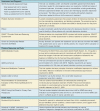Pediatric Attention-Deficit/Hyperactivity Disorder in Louisiana: Trends, Challenges, and Opportunities for Enhanced Quality of Care
- PMID: 31903060
- PMCID: PMC6928662
- DOI: 10.31486/toj.18.0103
Pediatric Attention-Deficit/Hyperactivity Disorder in Louisiana: Trends, Challenges, and Opportunities for Enhanced Quality of Care
Abstract
Background: Attention-deficit/hyperactivity disorder (ADHD) is a common pediatric condition with significant developmental, social, educational, and safety implications. The American Academy of Pediatrics has developed guidelines to support quality care of children with ADHD, but studies demonstrate that the guidelines are variably followed. Methods: This review highlights patterns of diagnosis and treatment of children with ADHD nationally and in Louisiana and provides examples of system- and practice-level opportunities to improve adherence to quality standards. Results: Possible contributors to the higher prevalence of ADHD and medication use in Louisiana compared to the nation are specialty workforce shortages, factors in the educational system, and factors associated with race and geography. Innovative system approaches have been developed to address workforce shortages and training limitations. Practice-level innovations include improving the use of validated measures, offering adequate scheduling, and identifying relevant resources and sharing the information with families. Conclusion: Despite the availability of evidence-based recommendations and resources, significant opportunities exist to provide enhanced ADHD care at the primary care level, especially in Louisiana where the high prevalence of some risk factors for ADHD and the high rates of ADHD and medication prescriptions have been noted nationally and at the state level. Attention to these factors can potentially help address these disproportionalities. Additionally, innovative models of training and collaboration in pediatrics are imperative. Pediatric clinicians, mental health providers, and families can work together to increase awareness about the needs of children and families affected by ADHD in medical, educational, and policy arenas and move the system forward for children.
Keywords: Attention deficit disorder with hyperactivity; Louisiana; pediatrics; primary health care.
©2019 by the author(s); Creative Commons Attribution License (CC BY).
Figures







Similar articles
-
A process for developing community consensus regarding the diagnosis and management of attention-deficit/hyperactivity disorder.Pediatrics. 2005 Jan;115(1):e97-104. doi: 10.1542/peds.2004-0953. Pediatrics. 2005. PMID: 15629972
-
Implementing the American Academy of Pediatrics attention-deficit/hyperactivity disorder diagnostic guidelines in primary care settings.Pediatrics. 2004 Jul;114(1):129-40. doi: 10.1542/peds.114.1.129. Pediatrics. 2004. PMID: 15231919 Free PMC article.
-
Use of practice guidelines in the primary care of children with attention-deficit/hyperactivity disorder.Pediatrics. 2004 Jul;114(1):e23-8. doi: 10.1542/peds.114.1.e23. Pediatrics. 2004. PMID: 15231969
-
Collaborative Care of Attention Deficit Hyperactivity Disorder: An Innovative Partnership to Serve Rural Pediatric Patients.J Pediatr Health Care. 2018 Nov-Dec;32(6):584-590. doi: 10.1016/j.pedhc.2018.05.003. Epub 2018 Jul 29. J Pediatr Health Care. 2018. PMID: 30064930 Review.
-
Diagnosis and treatment of attention deficit hyperactivity disorder (ADHD).NIH Consens Statement. 1998 Nov 16-18;16(2):1-37. NIH Consens Statement. 1998. PMID: 10868163 Review.
Cited by
-
State-Level Estimates of the Prevalence of Parent-Reported ADHD Diagnosis and Treatment Among U.S. Children and Adolescents, 2016 to 2019.J Atten Disord. 2022 Nov;26(13):1685-1697. doi: 10.1177/10870547221099961. Epub 2022 May 22. J Atten Disord. 2022. PMID: 35603751 Free PMC article.
References
-
- American Psychiatric Association. Diagnostic and Statistical Manual of Mental Disorders: DSM-5. 5th ed Arlington, VA: American Psychiatric Publishing; 2013.
-
- Visser SN, Danielson ML, Bitsko RH, et al. . Trends in the parent-report of health care provider-diagnosed and medicated attention-deficit/hyperactivity disorder: United States, 2003-2011. J Am Acad Child Adolesc Psychiatry. 2014. January;53(1):34-46.e2. doi: 10.1016/j.jaac.2013.09.001. - DOI - PMC - PubMed
-
- Danielson ML, Bitsko RH, Ghandour RM, Holbrook JR, Kogan MD, Blumberg SJ. Prevalence of parent-reported ADHD diagnosis and associated treatment among U.S. children and adolescents, 2016. J Clin Child Adolesc Psychol. 2018. Mar-Apr;47(2):199-212. doi: 10.1080/15374416.2017.1417860. - DOI - PMC - PubMed
Publication types
LinkOut - more resources
Full Text Sources
